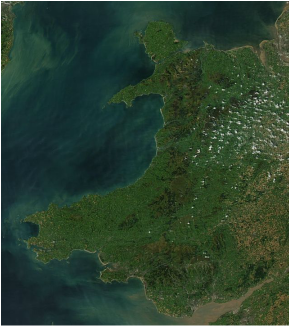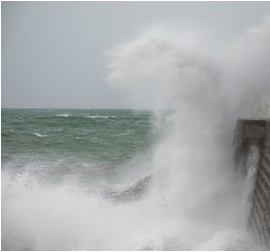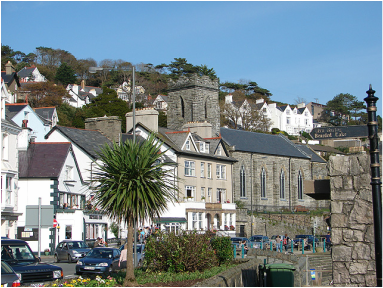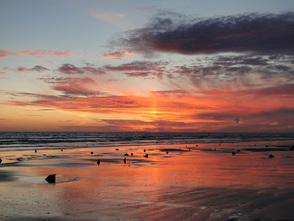Lost worlds: Cantre’r Gwaelod, Wales
By zteve t evans
 Cardigan Bay, Wales By NASA - Public Domain
Cardigan Bay, Wales By NASA - Public Domain
Locating Cantre’r Gwaelod
According to Welsh legend, Cantre’r Gwaelod was land inhabited by humans that became flooded by the sea through human neglect and folly. It was situated in what is now an area of sea in Cardigan Bay, Wales. There are many different versions of this legend which attempt to explain how a once rich and fertile land succumbed to the sea. There are also similar versions that exist in the British Isles referring to different locations. Another famous one originating outside of Britain comes from Brittany, France concerning the once beautiful city of Ys and of course there was Atlantis.
17th Century influences
From the 17th century onwards the following version appears to be the most popular. This tells that around 600 AD there was a land known as Cantre'r Gwaelod, or The Lowland Hundred. This land was said to extend 20 miles westwards from today's coastline into what is now Cardigan Bay.
It was also exceptionally rich and fertile but it was low lying and needed a dyke to protect it from the sea. The dyke had sluice gates that were opened when the tide was low allowing water to drain from the land into the sea but at high tide the gate was closed to protect the land from being flooded by the sea. The opening and closing of the dyke's gates was crucial to the safety of the land.
According to Welsh legend, Cantre’r Gwaelod was land inhabited by humans that became flooded by the sea through human neglect and folly. It was situated in what is now an area of sea in Cardigan Bay, Wales. There are many different versions of this legend which attempt to explain how a once rich and fertile land succumbed to the sea. There are also similar versions that exist in the British Isles referring to different locations. Another famous one originating outside of Britain comes from Brittany, France concerning the once beautiful city of Ys and of course there was Atlantis.
17th Century influences
From the 17th century onwards the following version appears to be the most popular. This tells that around 600 AD there was a land known as Cantre'r Gwaelod, or The Lowland Hundred. This land was said to extend 20 miles westwards from today's coastline into what is now Cardigan Bay.
It was also exceptionally rich and fertile but it was low lying and needed a dyke to protect it from the sea. The dyke had sluice gates that were opened when the tide was low allowing water to drain from the land into the sea but at high tide the gate was closed to protect the land from being flooded by the sea. The opening and closing of the dyke's gates was crucial to the safety of the land.

Gwyddno Garahir of Cantre'r Gwaelod
The ruler of the land was Gwyddno Garahir. In Welsh legend there are many rulers named Gwyddno but this one was said to be the sire of Elffin ap Gwyddno, who was the foster father of Taliesin the legendary Welsh bard.
Gwyddno Garahir, or Gwyddno Long-Shanks in English, was also reputed to be the keeper of one of the Thirteen Treasures of Island Britain which was said to be a magic basket which caused any food placed in it to multiply one hundred times. His main fortress was Caer Wyddno or Fort of Gwyddno and said to be situated to the northwest of the modern seaside town of Aberystwyth. According to this version around 600 AD a great storm blew out of the south west one night forcing the tide against the sea walls of the dyke.
Seithennin
Gwyddno had appointed his friend Seithennin to be one of two wardens of the dyke. It was his job to ensure the sluice gates of the dyke were operated properly. Seithennin was known to be a heavy drinker who liked a good night out. One night Gwyddno threw a party at his palace near Aberystwyth and being a friend of his, Seithennin attended. He drank a lot of beer and wine and some say he fell asleep, or was too intent on having a good time to notice the storm that was brewing outside. The sluice gates would need to be closed to protect the land from the high tide. But Seithennin had drunk too much and thoroughly enjoying the party and the sluice gates were left open. The tide surged through the dyke flooding all the land behind and more than sixteen villages.
Gwyddno and his company fled from the palace, They ran along Sarn Cynfelin which is a natural moraine that was created at the end of the last Ice Age. It is similar to a man-made causeway in appearance and it took them to dry land. Although the Lowland Hundred was flooded a good part of Gwyddno’s kingdom remained above sea level and was undamaged by the flood. The survivors settled there to make their living but the land was not as rich as the lowland had been.
The ruler of the land was Gwyddno Garahir. In Welsh legend there are many rulers named Gwyddno but this one was said to be the sire of Elffin ap Gwyddno, who was the foster father of Taliesin the legendary Welsh bard.
Gwyddno Garahir, or Gwyddno Long-Shanks in English, was also reputed to be the keeper of one of the Thirteen Treasures of Island Britain which was said to be a magic basket which caused any food placed in it to multiply one hundred times. His main fortress was Caer Wyddno or Fort of Gwyddno and said to be situated to the northwest of the modern seaside town of Aberystwyth. According to this version around 600 AD a great storm blew out of the south west one night forcing the tide against the sea walls of the dyke.
Seithennin
Gwyddno had appointed his friend Seithennin to be one of two wardens of the dyke. It was his job to ensure the sluice gates of the dyke were operated properly. Seithennin was known to be a heavy drinker who liked a good night out. One night Gwyddno threw a party at his palace near Aberystwyth and being a friend of his, Seithennin attended. He drank a lot of beer and wine and some say he fell asleep, or was too intent on having a good time to notice the storm that was brewing outside. The sluice gates would need to be closed to protect the land from the high tide. But Seithennin had drunk too much and thoroughly enjoying the party and the sluice gates were left open. The tide surged through the dyke flooding all the land behind and more than sixteen villages.
Gwyddno and his company fled from the palace, They ran along Sarn Cynfelin which is a natural moraine that was created at the end of the last Ice Age. It is similar to a man-made causeway in appearance and it took them to dry land. Although the Lowland Hundred was flooded a good part of Gwyddno’s kingdom remained above sea level and was undamaged by the flood. The survivors settled there to make their living but the land was not as rich as the lowland had been.
 St Peter's Church and Terrace Road Aberdyfi - geograph.org.uk - 1005740CC BY-SA 2.0 - OLU - From geograph.org.uk
St Peter's Church and Terrace Road Aberdyfi - geograph.org.uk - 1005740CC BY-SA 2.0 - OLU - From geograph.org.uk
A sacred well overflows
In one of the oldest versions Gwyddno’s daughter, Mereid, is the Maiden of the Well who treacherously allowed the water to overflow drowning the surrounding land. This is similar to the legend of the drowning of the old town of Bala now said to be under the waters of a lake where a sacred well was left uncovered and overflowed covering the town in water.
Mererid and Seithennin
In another version a beautiful maiden also named Mererid is the warden of the gates charged with their opening and closing at appropriate times. In this version Seithennin is a local king visiting the area who becomes enamoured with her. He is a renowned womaniser and heavy drinker and successfully seduces her. While she is with Seithennin a storm brews up and the sea flows through the open gates flooding the lowlands.
Poems and songs
There have been many poems and songs that have been inspired by the legend of Cantre'r Gwaelod over the centuries. Probably the earliest was called Boddi Maes Gyddno and found in the Black Book of Carmarthen. This book was written in 1250 and is named after the colour of its binding. This poem tells how the Mererid fails in her responsibility.
In most versions of the legend and in common with similar deluge legends from around the British Isles, it is said that when it is quiet, especially on Sunday mornings the ringing of church bells from under the sea can be heard. A well known 18th century song The Bells of Aberdyfi commemorates this. The town of Aberdyfi is believed to be the closest point to the mainland to the legendary lost land.
Caer Wyddno
Samuel Lewis in his book Topographical Dictionary of Wales in 1833 recorded that a feature of rocks and boulders in Cardigan Bay could sometimes be seen especially at low tides in the sea about seven miles west of Aberystwyth speculating this was Caer Wyddno.
Under the sea in Cardigan Bay there are a number of geological features called moraines which run at approximate right angles to the land. The way they gently slope from the sea up to the land looks like they were man-made causeways that gave access from the lowlands to the higher ground and has probably contributed to the idea of a lost land. In fact they are believed to be natural features formed by receding ice after the last Ice Age.
In one of the oldest versions Gwyddno’s daughter, Mereid, is the Maiden of the Well who treacherously allowed the water to overflow drowning the surrounding land. This is similar to the legend of the drowning of the old town of Bala now said to be under the waters of a lake where a sacred well was left uncovered and overflowed covering the town in water.
Mererid and Seithennin
In another version a beautiful maiden also named Mererid is the warden of the gates charged with their opening and closing at appropriate times. In this version Seithennin is a local king visiting the area who becomes enamoured with her. He is a renowned womaniser and heavy drinker and successfully seduces her. While she is with Seithennin a storm brews up and the sea flows through the open gates flooding the lowlands.
Poems and songs
There have been many poems and songs that have been inspired by the legend of Cantre'r Gwaelod over the centuries. Probably the earliest was called Boddi Maes Gyddno and found in the Black Book of Carmarthen. This book was written in 1250 and is named after the colour of its binding. This poem tells how the Mererid fails in her responsibility.
In most versions of the legend and in common with similar deluge legends from around the British Isles, it is said that when it is quiet, especially on Sunday mornings the ringing of church bells from under the sea can be heard. A well known 18th century song The Bells of Aberdyfi commemorates this. The town of Aberdyfi is believed to be the closest point to the mainland to the legendary lost land.
Caer Wyddno
Samuel Lewis in his book Topographical Dictionary of Wales in 1833 recorded that a feature of rocks and boulders in Cardigan Bay could sometimes be seen especially at low tides in the sea about seven miles west of Aberystwyth speculating this was Caer Wyddno.
Under the sea in Cardigan Bay there are a number of geological features called moraines which run at approximate right angles to the land. The way they gently slope from the sea up to the land looks like they were man-made causeways that gave access from the lowlands to the higher ground and has probably contributed to the idea of a lost land. In fact they are believed to be natural features formed by receding ice after the last Ice Age.
 Submerged forest at Ynyslas, Ceredigion - By Richerman
Submerged forest at Ynyslas, Ceredigion - By Richerman
Ancient deluge traditions
There are many legends from around the world which feature floods which cover rich lands and cities in water. Many people think these could be distant memories of the end of the last Ice Age. Great sheets of ice covered much of Northern Europe and North America. Between 17,000 and 7,000 years ago melting glaciers caused seas to rise flooding low lying land around the coastlines of the world. Melting glaciers sometimes flooding inland valleys. Although in most cases the changes to the land happened gradually over a period of time though sometimes with the right geological and weather conditions it could happen suddenly.
The earliest version referred to a well overflowing similar to the Lake Tegid legend where the goddess or spirit of the well required the well to be covered in the evenings. Everything was fine while this act took place but as soon as it was stopped the water in the well overflowed to drowned the entire area. Perhaps this was a distant memory of the early Christian era when pagan rites were being replaced by Christianity.
Religious or moral message?
Could it be that Cantre'r Gwaelod is a distant memory of distant events from the past and the stories are attempts to provide an explanation to these and later to provide a religious or moral message reflecting the social values of the day.
Celtic people often saw natural springs and wells as the dwelling place of a spirit or deity and the entrance or exit to the underworld. Covering up the well may have been symbolic of putting a cap on such beliefs and shutting off the underworld. When a cataclysmic natural event such as a flood occurred it may have been seen as opportunity to blame it on the pagan deities to encourage the Christian faith.
In later times the the hard drinking Seithennin was an example of what happens when one gives oneself over to the pleasures of alcohol for a Welsh society that favours temperance and abstinence. Similarly the seduction of Mereid by Seithennin is another warning of what happens when the pleasures of the flesh are given in to. Legends and stories such as these while keeping alive natural and real, or partly real events, also keep a live and make sense of morals and social ethics in ways that are meaningful and memorable for ordinary people.
The petrified forest of Borth and Ynyslas
More weight is given to the legend when it is remembered that Cardigan Bay was once home to a forest which was probably the home of animals and possibly humans around 7,000 years ago. The petrified remains of tree stumps can be seen at low tide especially at Borth and Ynyslas. However it cannot be proven that any kind of human civilisation existed where the sea covers the bay today. It is claimed that when water is clear and tides are low, walls and structures can be seen, yet no serious scientific investigation appears to confirm this.
A warning!
Many people think these legends of flooded lands are distant memories from the end of the Ice Age when melt waters inundated low lying lands, though as is the way with myths and legends, it is difficult to prove. Nevertheless, many of these legends act as a warning highlighting the result of immoral behaviour and encouraging good Christian values.
Copyright zteve t evans
There are many legends from around the world which feature floods which cover rich lands and cities in water. Many people think these could be distant memories of the end of the last Ice Age. Great sheets of ice covered much of Northern Europe and North America. Between 17,000 and 7,000 years ago melting glaciers caused seas to rise flooding low lying land around the coastlines of the world. Melting glaciers sometimes flooding inland valleys. Although in most cases the changes to the land happened gradually over a period of time though sometimes with the right geological and weather conditions it could happen suddenly.
The earliest version referred to a well overflowing similar to the Lake Tegid legend where the goddess or spirit of the well required the well to be covered in the evenings. Everything was fine while this act took place but as soon as it was stopped the water in the well overflowed to drowned the entire area. Perhaps this was a distant memory of the early Christian era when pagan rites were being replaced by Christianity.
Religious or moral message?
Could it be that Cantre'r Gwaelod is a distant memory of distant events from the past and the stories are attempts to provide an explanation to these and later to provide a religious or moral message reflecting the social values of the day.
Celtic people often saw natural springs and wells as the dwelling place of a spirit or deity and the entrance or exit to the underworld. Covering up the well may have been symbolic of putting a cap on such beliefs and shutting off the underworld. When a cataclysmic natural event such as a flood occurred it may have been seen as opportunity to blame it on the pagan deities to encourage the Christian faith.
In later times the the hard drinking Seithennin was an example of what happens when one gives oneself over to the pleasures of alcohol for a Welsh society that favours temperance and abstinence. Similarly the seduction of Mereid by Seithennin is another warning of what happens when the pleasures of the flesh are given in to. Legends and stories such as these while keeping alive natural and real, or partly real events, also keep a live and make sense of morals and social ethics in ways that are meaningful and memorable for ordinary people.
The petrified forest of Borth and Ynyslas
More weight is given to the legend when it is remembered that Cardigan Bay was once home to a forest which was probably the home of animals and possibly humans around 7,000 years ago. The petrified remains of tree stumps can be seen at low tide especially at Borth and Ynyslas. However it cannot be proven that any kind of human civilisation existed where the sea covers the bay today. It is claimed that when water is clear and tides are low, walls and structures can be seen, yet no serious scientific investigation appears to confirm this.
A warning!
Many people think these legends of flooded lands are distant memories from the end of the Ice Age when melt waters inundated low lying lands, though as is the way with myths and legends, it is difficult to prove. Nevertheless, many of these legends act as a warning highlighting the result of immoral behaviour and encouraging good Christian values.
Copyright zteve t evans
References and Attributions
Copyright January 21st, 2015 zteve t evans
Copyright January 21st, 2015 zteve t evans
